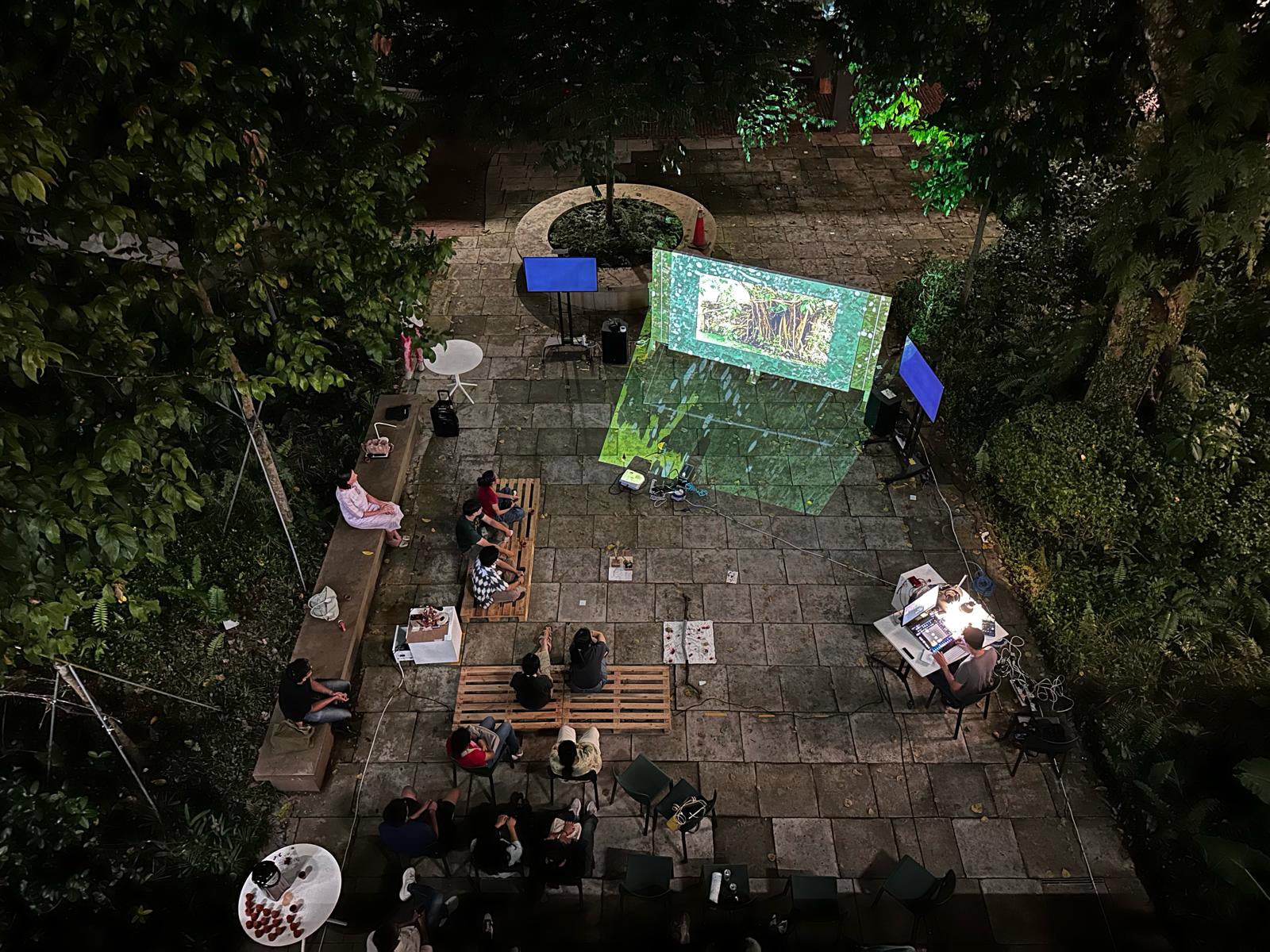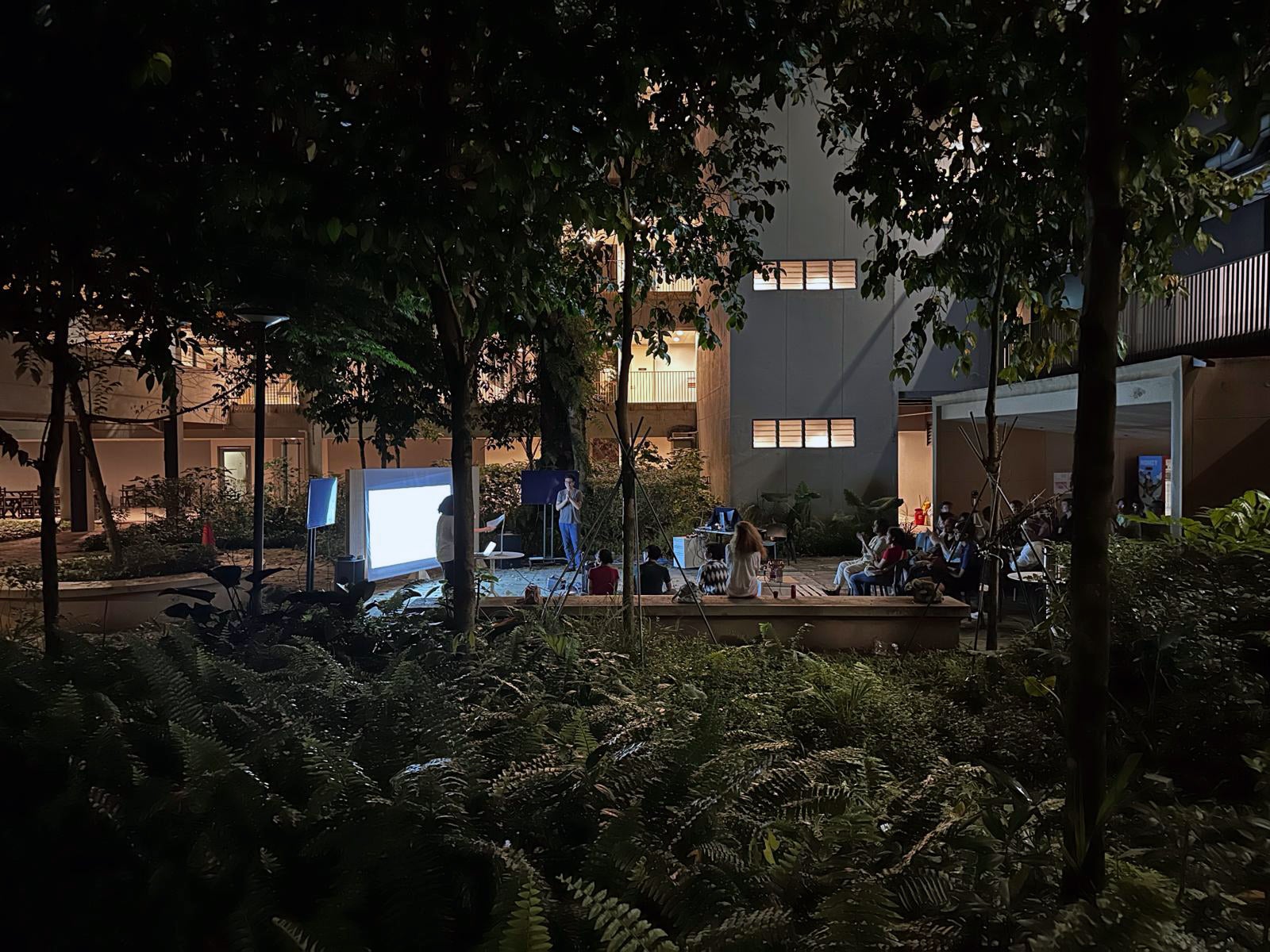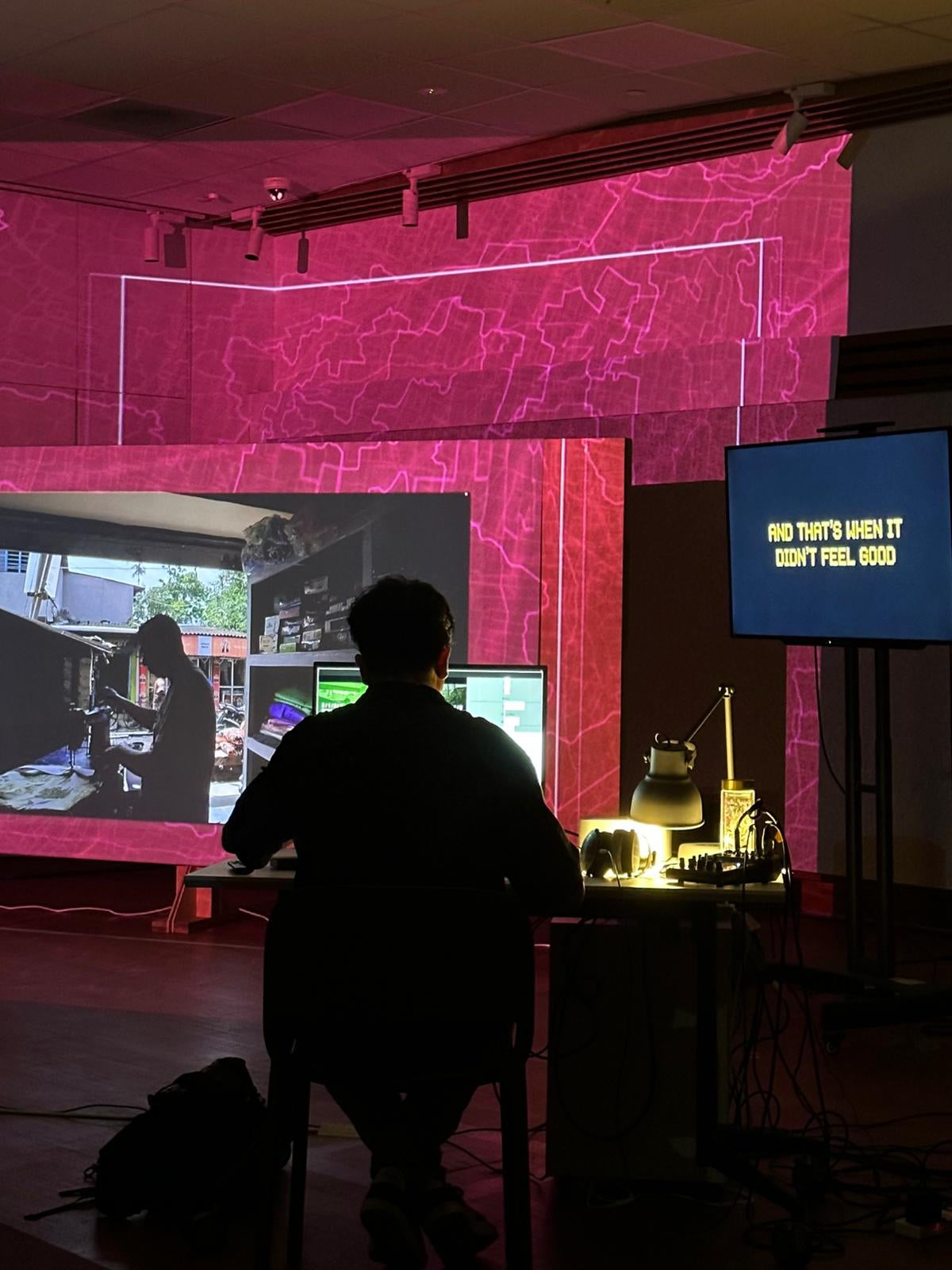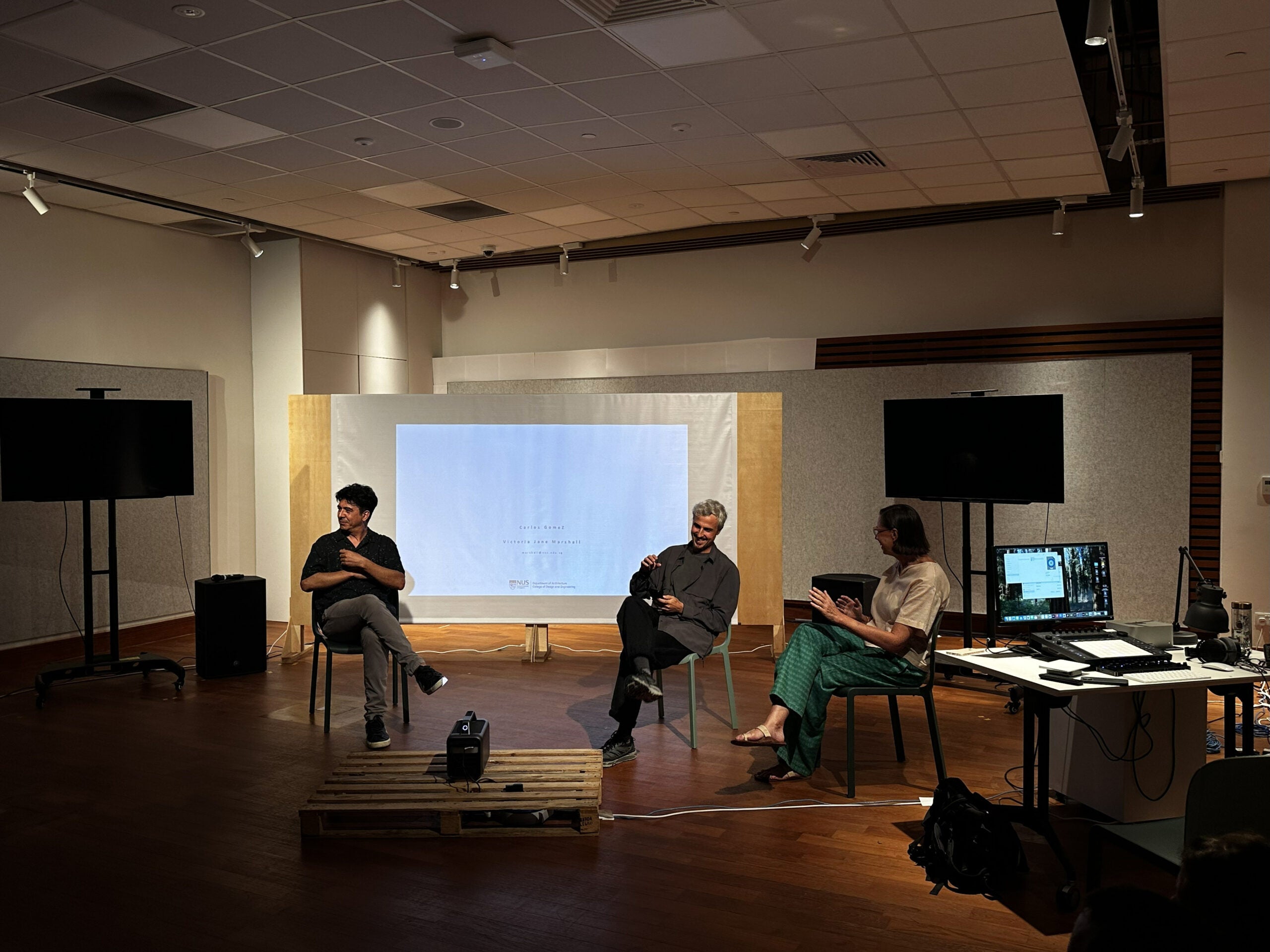Enacting Periurban Practice

From Oct 19-22 two linked events were staged at DOA. This Will Be Something: Cinematic cartographies of the post-rural is co-produced by Victoria Jane Marshall and filmmaker, Carlos Gomez. Co-Fabricating a Garden is led by DOA alumni Ruth Chong and Tang Wei. Both events were supported by DOA research assistants Hiral Patel and Lu Yixin. The overall project is supported by a Ministry of Education T1 grant entitled Enacting Periurban Practice, led by Victoria Jane Marshall.
This Will Be Something: Cinematic cartographies of the post-rural is performed with live editing, which means that each version is different. It was enacted twice in the Bodhi Garden (19 and 20 Oct) and once at the Grand Hall at the Department of Architecture (22 Oct) with respondent Federico Ruberto, senior lecturer DOA.
The student workshop entitled Co-Fabricating a Garden brought together students from landscape architecture and architecture. Through literary excerpts, contextualized sharing, multi-channel installation, and tactile workshops, students explored how they may see the Bodhi Garden in an alternative lens. Individually, or in small groups they created a garden element from found materials.
 This Will Be Something at the Bodhi Garden, Oct 20 (Source: Wei Kang, 2025).
This Will Be Something at the Bodhi Garden, Oct 20 (Source: Wei Kang, 2025).
 This Will Be Something post-screening discussion at the Bodhi Garden, Oct 20 (Source: Wei Kang, 2025).
This Will Be Something post-screening discussion at the Bodhi Garden, Oct 20 (Source: Wei Kang, 2025).
 Co-Fabricating a Garden installation by Jamie Loh in process, Oct 20 (Source: Victoria Marshall, 2025).
Co-Fabricating a Garden installation by Jamie Loh in process, Oct 20 (Source: Victoria Marshall, 2025).
 Co-Fabricating a Garden students and tutors, Oct 20. Participating students: Lee Huei Min (BLA); Daniel Britelit Joseph, Bi Hongying (B.Arch); Ruchira Bhagwat, Shruthakeerthi Karthikeyan, Arunachalam Kothai, Boddapati Krishna Sri, Li Jingyao, Wu Han, Zhao Fuhan, Zhou Qinying (MLA); Ni Kechun (Amy), Heymans Hin Ming Lo, Jamie Loh, Loh Kah Miin (M.Arch). (Source: Wei Kang, 2025).
Co-Fabricating a Garden students and tutors, Oct 20. Participating students: Lee Huei Min (BLA); Daniel Britelit Joseph, Bi Hongying (B.Arch); Ruchira Bhagwat, Shruthakeerthi Karthikeyan, Arunachalam Kothai, Boddapati Krishna Sri, Li Jingyao, Wu Han, Zhao Fuhan, Zhou Qinying (MLA); Ni Kechun (Amy), Heymans Hin Ming Lo, Jamie Loh, Loh Kah Miin (M.Arch). (Source: Wei Kang, 2025).
 Co-Fabricating a Garden exhibition, Oct 22. The workshop outcomes can be downloaded here. (Source: Ruth Chong, 2025).
Co-Fabricating a Garden exhibition, Oct 22. The workshop outcomes can be downloaded here. (Source: Ruth Chong, 2025).
 This Will Be Something at the Grand Hall, Oct 22 (Source: Ruth Chong, 2025).
This Will Be Something at the Grand Hall, Oct 22 (Source: Ruth Chong, 2025).

 This Will Be Something project architecture (Source: Carlos Gomez, Victoria Marshall, and diagram by Hiral Patel, 2025).
This Will Be Something project architecture (Source: Carlos Gomez, Victoria Marshall, and diagram by Hiral Patel, 2025).
This Will Be Something project architecture diagram. This Will Be Something: Cinematic cartographies of the post rural is a multichannel audiovisual work conceived to unfold as both installation and performance. Rather than documenting a fixed reality the installation performs a dynamic site responsive cartography. Grounded in the research of Victoria Jane Marshall and her book Periurban Cartographies: Kolkata’s Ecologies and Settled Ruralities (2024), the piece reflects on how urban futures are being shaped by hybrid constellations of human and non-human forces — continually producing both intentional and accidental landscapes. It is a dynamic that can evoke the uncertainty of a cultivated, enclosed garden, a metaphor mirrored in the form and logic of the piece itself. The installation is structured around three distinct yet interconnected video channels, complemented by spatialized multichannel sound. The audiovisual system is governed by a hybrid logic of manual control and generative logic, with semantic associations and audio signal input guiding the selection and modulation of content. The system grows and shifts in response to both its internal logic and external input. As a result, no two iterations of the work are identical. (Source: Carlos Gomez, Victoria Marshall, and diagram by Hiral Patel, 2025).
 This Will Be Something at the Grand Hall post-screening discussion with Federico Ruberto, Oct 22 (Source: Wei Kang, 2025).
This Will Be Something at the Grand Hall post-screening discussion with Federico Ruberto, Oct 22 (Source: Wei Kang, 2025).
Project Note
Victoria Jane Marshall
25/10/2025
Normative thinking considers the outer southwest of Kolkata as an urban edge or the periphery of the urban and as such, not much more than “becoming urban”. However, I think anew about such assumptions and point toward a larger, collective and comparative project of learning from multifaceted “kinds of urban” everywhere. Especially of interest are those settlement conditions that are “off the map” of widely circulating approaches for analyzing and shaping urbanization, like the ordinary, long-settled landscapes of Monsoon Asia.
Although there is uneven development and pollution in the featured locality, it is not the only thing to see. As This Will Be Something shows, when paddy cultivation stops in the outer southwest of Kolkata, the infrastructural legacies of the settled-rural; like ponds, plantations, home gardens, micro topographies created from local land-shaping, and modest, multifamily homes do not just disappear – they persist. Vegetation, water, and darkness are forceful and do work to shape space and subjectivity. That is, the post-rural landscape is powerful. As argued by architect Stephen Cairns (2018, p. 120), urban effects and opportunities are “uniquely absorbed” by pre-existing rural settlement conditions. Then again, as noted geographer Mathew Gandy (2022), “urban nature”, like the post-rural landscape, is important for its function as “ruins and refugia”. Urban nature is vital to meaning and ecological value as settlements densify.
To render this dynamic in my book Periurban Cartographies: Kolkata’s ecologies and settled ruralities (2024b), I engaged a set of methods that built on my training in landscape architecture and urban design, and I linked it with participant interviews and critical mapping from geography. I visualized and narrated how the featured locality “will be something” but it may not be what is expected for those who view it only as empty space available to receive a known urban. As noted by planner Xiang (Yenny) Li (2025, p. 56), “the monograph’s brilliance manifests in revolutionizing mapmaking processes as political praxis against dominant knowledge production”. More broadly, the project has been praised as a situated approach that “offers a challenge for urban scholars to explore the informality of ecologies and how peripheries might provide original epistemologies” (Tzaninis et al., 2025, p. 3).
In 2024, I decided to advance the project for numerous reasons. First, I want my linked maps and narratives to express sensory experiences and the multifaceted qualify of the post-rural that are hard to put into words and hard to picture in static, two-dimensional visualizations. Second, I want to invent a participatory method that fits the context. Third, I want to empower my landscape architecture and architecture students to also engage in creative design research on the topic of the periurban and to become accomplished, periurban practitioners (see Gillick, 2024). For I believe this particular form of urbanism that is coming into being, and others of its kind across Monsoon Asia hold important questions for practice in the spatial design fields, of landscape architecture, architecture, and urban design.
To achieve these goals, I decided to collaborate with a filmmaker. I met Carlos Gomez at the Flaherty Film Seminar entitled To Commune (June 27-July 2, 2024), and we have been working together on This Will Be Something since then. To connect with participants, we enacted local screenings in Ward 13, Maheshtala, Kolkata in December 2024 (see Marshall, 2024a). We followed up with in-depth interviews in February 2025, and we visited the locality during monsoon in June 2025. Our fieldwork was facilitated by Bengali research assistants, geographer Dipanwita Manna and film curator Ankit Bagchi.
The announcement of This Will Be Something: Cinematic cartographies of the post-rural and description three-day media event at DOA can be found here.
https://cde.nus.edu.sg/arch/news_and_events/events_ay2526_ls_something_191025/
More-than-human Acknowledgements.
Thank you to Goh Zhi Xian Sheryl for the excellent and helpful facilities coordinating. Thank you to Nasi Ulam Forest Garden for being so fertile and productive for foraging. Thank you to the Bodhi Tree for waving in the wind at just the right moment. Thank you to all of the Malaysian Cherry Trees for giving inspiration, shade, and juice. Thank you to the jungle fowl and the bats for delivering spectacular animal action. Thank you to the rain for staying away. We love you rain, but we are happy you headed East. Lastly, thank you to SDE1, SDE3, and EW1 for giving form to the garden enclosure and for providing many vantage points to view the event.
References
Cairns, S. (2018). Debilitating city-centricity: Urbanization and urban-rural hybridity in Southeast Asia. In R. Padawangi (Ed.), Routledge Handbook on Urbanisation in Southeast Asia (pp. 115–129). Routledge.
Gandy, M. (2022). Natura Urbana: Ecological constellations in urban space. MIT Press.
Gillick, A. (2024). Victoria Jane Marshall: Mapping the Periurban (No. 110) [Broadcast]. https://podcasts.apple.com/gb/podcast/victoria-jane-marshall-mapping-the-periurban/id1588790585?i=1000660359561
Li, X. (Yenny). (2025). Periurban Cartographies: Kolkata’s ecologies and settled ruralities [Book Review]. Journal of Urban Political Ecology, 1(1–2), 55–58.
Marshall, V. (2024a). Enacting Periurban Practice [Professional practice]. Till Design. https://tilldesign.com/ENACTING-PERIURBAN-PRACTICE
Marshall, V. (2024b). Periurban cartographies: Kolkata’s ecologies and settled ruralities. ORO Editions.
Tzaninis, Y., Kaika, M., Mandler, T., & Keil, R. (2025). Special Issue – Imagining with UPE for a Burning World. Journal of Urban Political Ecology, 1(1–2), 1–4.